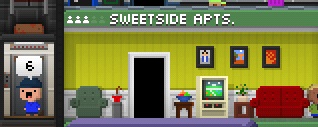Tiny Tower (iOS)

“Sorry, I don’t normally do this,” I apologize as I pull my vibrating iPhone from my pocket. My friend continues to tell me about her thesis while I restock the sushi bar or floor three of my tiny tower. I’m about to put my phone away again when I realise that the laundromat on floor seven also needs to be restocked. And an old lady is in the elevator, waiting to be taken to the apartments of floor eleven. “Sorry,” I repeat and chuckle nervously. “I hate it when people do this.”
Later in the day, my girlfriend and I are in the car returning home from the university. She pulls up at the traffic lights and immediately grabs her iPhone from the dashboard. She fiddles with her tower until the lights turn green. When they do, she curses and passes the phone to me. “Can you finish restocking the coffee shop?”
Hyperbolic comparisons between videogames and society’s vices are usually clichéd and unfair, but sitting in the car, playing two instances of the same game on two iPhones simultaneously, I am willing to make an exception: Tiny Tower is a drug, easily enjoyed and easily abused. In moderation it is an absolute blast to play, with compelling-yet-simplistic gameplay, an intuitive interface and utterly adorable visuals. Yet, to play Tiny Tower only ‘in moderation’ can be more challenging than the game itself.
Tiny Tower is a simplified management sim that sees the player constructing and maintaining a self-contained tower of residential and commercial floors. Cute little ‘bitizen’ tenants move into the residential floors and can be given jobs at the various types of stores. As more bitizens move in and begin work, stores can stock more items and players slowly accumulate more money with which to build more floors and attract yet more bitizens. Maintaining cash flow becomes a task of keeping stores stocked and giving the right job to the right bitizen. Put the most efficient bitizens in the most suitable stores and they will sell items quicker, buy new items cheaper, and restock the store faster, allowing players to become richer and build their tower taller.
The catch is how long these actions can take to complete. New deliveries of sold-out items can take anywhere from two minutes to two hours while each new floor will take about half an hour longer to construct than the previous one. Fortunately, the clock continues to run in real-time while you are not playing. Construction and deliveries continue as you go about your day, but so too do to your sales. Despite all the bitizens in your employment, it is the player who must do all the work.  Once new items have finally been delivered, they can’t be sold until the player returns to the game to stock them. Which makes ignoring Tiny Tower very, very difficult. Unlike your typical addictive game, you do not simply walk way from Tiny Tower; it is always with you, in your pocket or your bag, insisting and demanding that you pay attention to it (in this way, it is much the same as Zynga Facebook games like FarmVille and CityVille). Sure, you can always put it aside for sleep, work, loved-ones, or other menial real-world commitments, but stores are certain to sell-out if you ignore them for too long and your cash flow, therefore, is certain to falter.
Once new items have finally been delivered, they can’t be sold until the player returns to the game to stock them. Which makes ignoring Tiny Tower very, very difficult. Unlike your typical addictive game, you do not simply walk way from Tiny Tower; it is always with you, in your pocket or your bag, insisting and demanding that you pay attention to it (in this way, it is much the same as Zynga Facebook games like FarmVille and CityVille). Sure, you can always put it aside for sleep, work, loved-ones, or other menial real-world commitments, but stores are certain to sell-out if you ignore them for too long and your cash flow, therefore, is certain to falter.